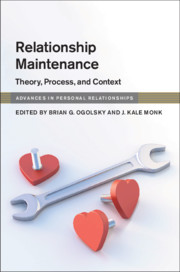Book contents
- Relationship Maintenance
- Advances in Personal Relationships
- Relationship Maintenance
- Copyright page
- Contents
- Tables
- Figures
- Contributors
- Part I Introduction
- Part II Theories of Relationship Maintenance
- 2 Interdependence Perspectives on Relationship Maintenance
- 3 An Evolutionary, Life History Theory Perspective on Relationship Maintenance
- 4 Relationship Maintenance from an Attachment Perspective
- 5 Uncertainty Perspectives on Relationship Maintenance
- 6 The Self-Expansion Model and Relationship Maintenance
- Part III Processes of Relationship Maintenance
- Part IV The Social Context of Relationship Maintenance
- Part V Conclusion
- Index
- References
5 - Uncertainty Perspectives on Relationship Maintenance
from Part II - Theories of Relationship Maintenance
Published online by Cambridge University Press: 02 December 2019
- Relationship Maintenance
- Advances in Personal Relationships
- Relationship Maintenance
- Copyright page
- Contents
- Tables
- Figures
- Contributors
- Part I Introduction
- Part II Theories of Relationship Maintenance
- 2 Interdependence Perspectives on Relationship Maintenance
- 3 An Evolutionary, Life History Theory Perspective on Relationship Maintenance
- 4 Relationship Maintenance from an Attachment Perspective
- 5 Uncertainty Perspectives on Relationship Maintenance
- 6 The Self-Expansion Model and Relationship Maintenance
- Part III Processes of Relationship Maintenance
- Part IV The Social Context of Relationship Maintenance
- Part V Conclusion
- Index
- References
Summary
This chapter focuses on the ways that relational uncertainty can both shape and reflect relationship maintenance behaviors. Relational uncertainty reflects questions about the nature or degree of involvement in close relationships. Relational uncertainty can shape relationship maintenance because, under these conditions, people lack a sufficient framework to guide their own behavior or properly interpret the actions of a partner, which could prevent people from taking actions to maintain or bolster the relationship. When people fail to enact relationship maintenance, the interpersonal climate in the relationship can also give rise to increased questions and uncertainty about relational involvement. This chapter begins by reviewing the different types of uncertainty that can exist in close relationships and describes theory that explicates the role of uncertainty in interpersonal relations. Then, the chapter discusses the ways in which relational uncertainty can be an antecedent to relationship maintenance or an outcome of relationships that are not sufficiently maintained. Finally, the chapter concludes by exploring opportunities for future research on relational uncertainty and relationship maintenance.
Keywords
- Type
- Chapter
- Information
- Relationship MaintenanceTheory, Process, and Context, pp. 69 - 85Publisher: Cambridge University PressPrint publication year: 2019
References
- 1
- Cited by

